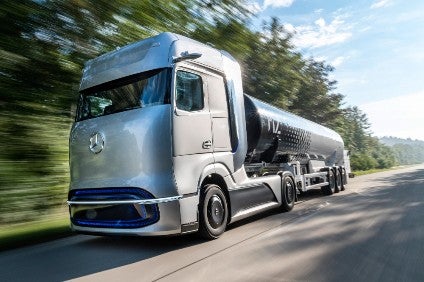
Linde and Daimler Truck have signed an agreement to jointly develop liquid hydrogen refueling technology for fuel cell powered trucks to make the process as easy and practical as possible.
Together, the companies will focus on a new process for handling liquid hydrogen (subcooled liquid hydrogen, sLH2 technology).

Discover B2B Marketing That Performs
Combine business intelligence and editorial excellence to reach engaged professionals across 36 leading media platforms.
This innovative approach allows for higher storage density, greater range, faster refueling and superior energy efficiency. The new process will use higher than ambient pressure levels and special temperature control which avoids so called boil off effects and return gas (gas from the vehicle tank returning to the filling station) during refueling and will not require complex data communication between the filling station and the truck during refueling.
Overall, the technology allows simpler filling station concepts. The improved energy storage density is due to the higher than ambient pressure level which increases the hydrogen mass in the tank.
The companies plan for the first refueling of a prototype vehicle at a pilot station in Germany in 2023. The two firms are planning for a high level of transparency and openness around the relevant interfaces of the jointly developed technology. By enabling as many other companies as possible to develop their own refueling and vehicle technology which apply the new liquid hydrogen standard, a global mass market is to be established for the new process.
Daimler Truck plans to begin customer trials of its GenH2 Truck in 2023; series production is to start in the second half of the decade. Thanks to the use of liquid instead of gaseous hydrogen with its higher energy density, the vehicle’s series version performance is planned to equal that of a comparable conventional diesel truck. The new fueling process is to be implemented in the series version of the GenH2 Truck and first to be validated in upcoming prototypes.

US Tariffs are shifting - will you react or anticipate?
Don’t let policy changes catch you off guard. Stay proactive with real-time data and expert analysis.
By GlobalDataDaimler Truck prefers to use liquid hydrogen because in this state, the energy carrier has a far higher energy density in relation to volume than gaseous hydrogen. As a result, the tanks of a fuel cell truck using liquid hydrogen are much smaller and, due to the lower pressure, significantly lighter. This gives the trucks more cargo space and a higher payload. At the same time, more hydrogen can be carried, which significantly increases the trucks’ range. This makes the series GenH2 Truck, like conventional diesel trucks, suitable for multi day, difficult to plan long haul transport and where the daily energy throughput is high.
Daimler Truck is currently pressing ahead with the development of the necessary tank system technology to make liquid hydrogen usable also in mobile applications as an energy source for series produced fuel cell trucks. The storage of cryogenic liquid hydrogen at minus 253 degrees Celsius is already common practice in stationary applications, for example in industry or at hydrogen filling stations. This also applies to the transport of liquid hydrogen as cargo.





